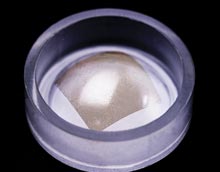From the Labs: Information Technology
Electronic Eye
Stretchable circuits enable a high-quality spherical camera

Source: “A hemispherical electronic eye camera based on compressible silicon optoelectronics”
John Rogers et al.
Nature 454: 748-753
Results: Using a stretchable electronic circuit, researchers at the University of Illinois at Urbana-Champaign have designed a curved, 256-pixel camera sensor that produces small but high-quality images using a simple lens.
Why it matters: Unlike the human eye, with its single lens, camera lenses require multiple components to correct for distortions and aberrations that result from focusing light onto a flat surface, such as a strip of film or a conventional digital light sensor. A curved sensor doesn’t require as many lens components to capture high-quality images, so lenses can be simpler and lighter.
Methods: On a silicon wafer, the researchers used conventional lithography to fabricate an array of 500-by-500-micrometer silicon light sensors connected by metal ribbons. They removed the array from its silicon substrate by means of a chemical process. Next, the researchers used a mold to fabricate a film of flexible silicone in the shape of a bowl. Then they stretched the film flat and applied the sensor array. When they released the silicone, it returned to its bowl-like shape, curving the sensor array in the process. The metal ribbons, which are thin enough to be flexible, allow the array to bend without breaking. Finally, the researchers incorporated the array into a camera with a simple lens and electronics.
Next steps: The researchers are trying to make higher-resolution cameras that have more sensors, and they hope to use different types of curved surfaces to optimize the imaging.
Better Face Recognition
A new algorithm improves automated recognition of faces in low-resolution images.
Source: “Recognition of Low-Resolution Faces Using Multiple Still Images and Multiple Cameras”
Pablo Hennings-Yeomans et al.
IEEE International Conference on Biometrics: Theory, Applications, and Systems, September 29-October 1, 2008, Crystal City, VA
Results: Researchers at Carnegie Mellon University and Microsoft Research have built a system that improves automated recognition of faces in low-resolution images.
Why it matters: Low-resolution images from surveillance and traffic cameras, cell-phone cameras, and webcams aren’t much use for automatic face recognition, because they lack fine detail. The new system, however, can yield accurate matches from low-quality images. It could be used to search for specific faces on websites, and law-enforcement officials could use it to find suspects in surveillance videos.
Methods: Face recognition systems are usually trained on databases that include many high-resolution images of faces. That teaches them a technique called feature extraction: they learn to associate patterns of pixels with physical traits, such as a particular slant of the eyes. This training, however, doesn’t equip the systems to handle low-resolution images very well. Existing algorithms can increase images’ resolution–adding pixels to smooth out curves, for example. But while the results look better to human beings, the process can cause distortions that lead to errors in automated face recognition. The researchers developed algorithms that improve resolution in ways that take into account the requirements of feature extraction, increasing the accuracy of face identification.
Next steps: Face recognition systems need further improvements to correctly identify images taken from unusual angles. The researchers will also investigate other applications of image recognition–in biomedical imaging, for instance.
Keep Reading
Most Popular
Large language models can do jaw-dropping things. But nobody knows exactly why.
And that's a problem. Figuring it out is one of the biggest scientific puzzles of our time and a crucial step towards controlling more powerful future models.
How scientists traced a mysterious covid case back to six toilets
When wastewater surveillance turns into a hunt for a single infected individual, the ethics get tricky.
The problem with plug-in hybrids? Their drivers.
Plug-in hybrids are often sold as a transition to EVs, but new data from Europe shows we’re still underestimating the emissions they produce.
Stay connected
Get the latest updates from
MIT Technology Review
Discover special offers, top stories, upcoming events, and more.